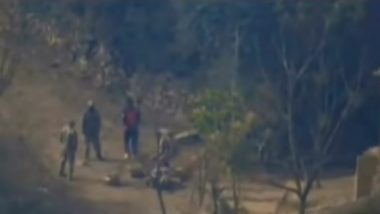New Delhi, September 28: Three years ago, the Indian Security forces carried out 'Surgical Strikes' across the border and eliminated terrorists. The operations carried out by the security forces on the intermittent night of September 28-29 made the whole of India aware about surgical strikes. So what are surgical strikes and what is the history of surgical strikes. Surgical Strike Video: Fresh Visuals of September 29, 2016, Indian Army Operation in PoK Surface.
Some 11 days after the attacks, the Indian security forces carried out Surgical strikes across the border and gave a befitting reply to the enemy. The strikes are now a part of Indian Armed forces folklore, known as Uri surgical strikes which also caught the attention of the cultural and art milieu in India. Surgical Strikes After Uri Terror Attack: Remembering Heroes of Indian Army's Daring Cross-Border Mission That Stunned Pakistan.
What is Surgical Strike?
Surgical strike's definition is, “An attack (usually without prior warning) intended to deal only with a specific target.”
The aim of the surgical strike is to do maximum damage to enemy without causing much fuss and destruction to the civilians in the target area.
Surgical strikes can be done via air strikes as well as ground operation. What matters is the execution and the style of attack on enemy and the target.
Who Did a Surgical Strike First?
Israel's Operation Focus, targetting Egyptian Air Force, is considered to be the first modern example of Surgical Strike. Osama Bin Laden's killing by the US Navy SEALS in 2011 is also considered an example of surgical strike.
Uri - The Attack
19 martyrs of the Indian Army were martyred in the dastardly Uri attacks carried out by terrorists who crossed the Line of Control (LoC) on September 18, 2016. It was one of the worst attacks on the Indian Army in time of no-war situation before the Pulwama terror attack claimed the lives of 40 security personnel on February 14, 2018.
In the wee hours of September 18, 2016, four heavily armed terrorists attacked a strategic location in the Uri town on the Indian Army personnel sleeping in the tents across a temporary fuel station.
The attacks shook the nation and shaped India's policy of no tolerance towards terror approach in days to come. It was around 5:30 am on 18 September, that four militants attacked an Indian Army brigade headquarters in Uri, near the Line of Control in early morning ambush. They lobbed 17 grenades in three minutes. The base camp with tents caught fire, killing army personnel during the attack.
Uri- The Surgical Strikes: India's Reply
The surgical strikes were carried out by the Indian Army in Bhimber, Hotspring, Kel and Lipa sectors in the Pakistan side of the Line of Control. The Army and Special Forces commandos were airdropped at the LoC from where they crossed to the Pakistani side.
A few days ago, former Nagrota Corps commander Lt Gen Rajendra Nimborkar said that they carried leopard urine while carrying out the strike as they knew that dogs were scared of leopards and would not bark if they smell leopards around.
"There was a possibility of dogs in villages barking at us on the route. I knew they are scared of leopards. We carried leopard urine with us & that worked & dogs didn't dare to come forward," he said. The Indian jawans entered 3 km into the Pakistan side and destroyed at least seven terror camps while killing 38 terrorists and two Pakistani jawans.
(The above story first appeared on LatestLY on Sep 28, 2019 07:13 PM IST. For more news and updates on politics, world, sports, entertainment and lifestyle, log on to our website latestly.com).













 Quickly
Quickly












